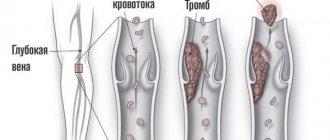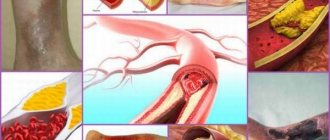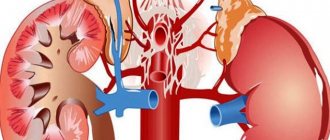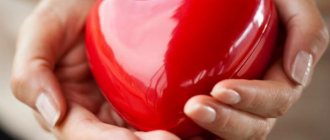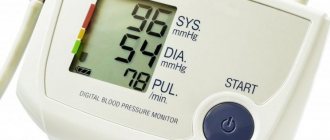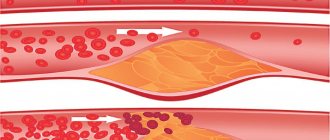Everything in the body must be in balance - only then all systems and organs work normally. Even the smallest atoms and substances affect balance. Salts of sodium, potassium, magnesium, chlorine and other metals are regulators of metabolic reactions, water levels in the blood and some factors in the body. To ensure their daily requirement, it is enough to consume 6-7 grams of iodized seasoning. An excess of any salts causes various unpleasant symptoms, because their deposits poison the body, disrupt the water balance, cause stagnation of excess fluid, and much more.
Symptoms of excess salts
To ensure the daily requirement of chemicals, not many chemicals are needed, but people often eat incorrectly, self-prescribe “vitamins to improve health,” do little exercise and completely forget about drinking water. All this causes deposits of excess substances in muscles, blood vessels, organs (especially the kidneys and liver), and joints.
Excess salt makes itself felt almost immediately, because its symptoms affect not only the internal state of organ systems, but also a person’s appearance and well-being. Everyone should know the signs of excess salts:
- swelling of the face appears, especially around the eyes;
- constant feeling of thirst, you just want water;
- allergic rashes on the body (in the chest, back, arms);
- unreasonably high blood pressure;
- accelerated heart rate (pulse);
- pain or discomfort in the joints;
- lack of appetite;
- frequent headaches or dizziness;
- eye irritation;
- lethargy, loss of strength;
- a small amount of dark yellow urine with a distinct odor of ammonia;
- rare urge to go to the toilet;
- constipation.
Most symptoms are due to the fact that salts actively interact with water, absorbing it. Their excess takes away the water the body needs. Because of this, the blood thickens, so the pressure rises and the pulse accelerates, the heart suffers.
Also, excess salts cause a false feeling of thirst in the hypothalamus (the part of the brain responsible for the constancy of the internal environment in the body) - this is how the body tries to dilute the concentrated saline solution. Although an excess of salts causes a lack of fluid, edema can also occur, due to the deposits of these substances form in the tissues and attract water locally.
If such symptoms are present, it is necessary to consult a specialist and undergo examination, tests and treatment, because such a condition cannot be triggered, since a constant excess of salt disrupts the functioning of many organs and causes their diseases.
What happens when there is too much salt?
Muscle tissue, kidneys, cardiovascular and nervous systems suffer the most, because it is here that these substances perform many different functions.
Muscle
In addition to retaining water, excess salt stretches muscle fibers, weakens and destroys them, it also affects their contraction. Without delving into the complex jungle of anatomy, it is worth knowing that in order to excite a muscle, the activity of the sodium-potassium pump and passage channels in the nerves are regulated. Due to an excess of elements, this process may be disrupted and the muscles react poorly to impulses.
Kidneys
These natural filters in the human body suffer more than all other organs. Excess salt can cause kidney failure, nephritis, inflammation of the canals and other unpleasant symptoms. This happens due to the fact that the kidneys must work several times harder in order to filter as much water as possible back into the body and release deposits of excess salt and toxic ammonia.
Cardiovascular and nervous systems
Due to blood thickening, chronic hypertension appears and the pulse increases. This puts a lot of stress on the heart, so arrhythmia and tachycardia can develop, and the risk of stroke also increases. Also, fatty deposits (plaques) may appear on the walls of blood vessels, which, when they come off, cause a heart attack or death.
The brain and peripheral nervous system cannot avoid the harmful effects of excess salts in the body, because these substances are one of the main participants in the conduction of nerve impulses in neurons. Also, an excess of them creates constant stress in the hypothalamus, reducing its regulatory function. Because of this, the finest regulation of processes in the body is disrupted.
Main symptoms and treatment of chronic pyelonephritis in women
Pyelonephritis is a nonspecific inflammation of an infectious nature that affects the parenchyma, tubular system or renal pelvis. This pathology is considered severe and extremely difficult to cure.
Chronic pyelonephritis is much more often found in women. Its symptoms and treatment are described below.
The susceptibility of the fairer sex to the disease is explained, first of all, by the structural features of their body. They have a very short urinary canal (no more than 20 mm) - thanks to this, pathogenic bacteria penetrate inside absolutely unhindered. Moreover, most often infection occurs due to the close proximity of the urethra and anus.
Today, approximately a third of all diseases of the genitourinary system are caused by pyelonephritis. The difficulty of timely diagnosis is due to the absence of a pronounced symptomatic picture of the disease. Nephrologists specialize in the treatment of pathology.
How to get rid of excess salt
Before any independent treatment, you should consult a doctor, because self-medication can be dangerous to everyone’s health!
To get rid of excess salts in the body, use the following methods:
- diet;
- drug treatment;
- ambulatory treatment.
Diet
This method involves getting rid of salt deposits at home. It is completely safe for health, because you do not need to use various medications. The body needs to receive 6-7 grams of salt per day (1 teaspoon). It can be regular table water, iodized, but it is best to choose sea water, because it contains 80% of the necessary minerals.
- When creating a menu for yourself, write down not only the products you are going to eat, but also the amount of salt needed to prepare them.
- One meal should contain no more than 2 grams of the chemical.
- It is not necessary to salt food, because many foods contain the necessary elements (seaweed, fish, green vegetables, citrus fruits).
- You should also get rid of fast food products that can contain your entire daily salt intake in 1 serving! Manufacturers add so much seasoning to improve the taste of the dish.
Do not forget about ordinary water, which is an indispensable fighter against salt deposits. It will help the kidneys remove excess substances and improve their cleansing. Regular consumption of water will thin the blood, reducing the risk of clots or plaques. It is enough to drink 2.5 liters of boiled water to maintain the balance of substances in the body.
Drug treatment
This method should be used only after consulting a doctor. He may prescribe various medications to enhance elimination and block salt deposits. Doctors also often advise completely avoiding salting foods yourself, and instead drink a solution from a special salt packet once a day, 1 hour after eating.
Causes of excess salt
There may be several reasons for the deposition of excess salts:
- hereditary predisposition;
- poor nutrition, abuse of fast food and processed foods;
- regular salting of food;
- independent use of various mineral preparations;
- small amount of water consumed;
- type 2 diabetes (insipidus).
There are also individual reasons that a specialist can understand.
Excess salt is dangerous for the health of the entire body, so you need to know the symptoms of such a deviation, because its timely elimination will help get rid of the negative consequences of chronic excess. Also remember that you cannot choose a treatment for such a serious disorder on your own, so if you notice signs of excess minerals, consult a doctor.
Uric acid cleanses organs of nitrogenous compounds. It is a sodium salt that is part of the blood plasma and intercellular fluid. The content of urate salts in the blood reflects the balance of their synthesis and utilization.
Other Applications
Lactate concentrate has shown its effectiveness in removing warts, calluses, and tartar.
In the food industry, lactic acid is known as a preservative additive E270, which improves taste. This substance is considered safe for humans. Included in salad dressings, confectionery products, and in infant formula.
In pharmacology, lactate is used to create bactericidal agents. And in light industry this substance is used in the production of leather products.
Today you learned the most interesting facts about lactate and its effect on the body. Now you know how to use lactic acid with maximum benefit for your health and beautiful appearance. And most importantly, where to look for sources of this useful substance.
4,96 (60 )
Lactic acid (lactate)
- the end product of glycolysis (aerobic breakdown of glucose). The glycolysis reaction splits a glucose molecule into pyruvate molecules. With sufficient oxygen supply, pyruvate is metabolized in the mitochondria to water and carbon dioxide. Under anaerobic conditions, when there is insufficient oxygen supply, pyruvate is converted to lactate. Under resting conditions, the main source of lactate in plasma is erythrocytes. During exercise, lactate is released from the muscles, converted to pyruvate in the liver, or metabolized by brain tissue and the heart. A small amount of lactate is always present in the bloodstream. The concentration of lactate in the blood increases during tissue hypoxia due to decreased tissue perfusion or decreased oxygen content in the blood. Accumulation of lactate can reduce blood pH and lead to metabolic acidosis (changes in the body's acid-base balance as a result of insufficient excretion and oxidation of organic acids).
An increase in lactate concentration reflects the degree of tissue ischemia. The lactate content in the blood during hypoxic conditions increases according to the severity of hypoxia. Accumulation of lactate is one of the causes of coma, in particular, hyperlactic acidemic diabetic coma.
Venous blood lactate is a valuable diagnostic test for assessing the severity of shock and preexisting conditions. Lactate levels correlate with poor prognosis in the perioperative period, in the intensive care unit, and in the intensive care unit.
One of the latest trends in traumatology, critical and emergency medicine, and anesthesiology is the determination of lactate levels in patients with injuries or serious illnesses.
Lactate concentrations during exercise correlate with the development of fatigue. The test is used in sports medicine to assess the level of physical activity.
In pathology, lactic acidosis (blood acidification due to the accumulation of lactate) is most often observed with a decrease in oxygen delivery to tissues (type A), due to decreased blood flow (shock, sepsis) or a decrease in the partial pressure of oxygen (severe lung diseases, breath holding). Less commonly, lactic acidosis is caused by metabolic changes that lead to increased lactate production (type B), such as increased muscle activity (excessive exercise, status epilepticus), tumors (especially leukemia and lymphoma), or changes in liver metabolism (alcohol intoxication).
Lactate is a metabolic product of propylene glycol, which is part of the solvent for many intravenous drugs. In patients with reduced renal function, prolonged infusions of such solutions may accumulate increased amounts of lactate.
Indications for the purpose of the study:
- Assessment of oxygen supply to tissues in shock and circulatory disorders.
- Assessing the cause of acidosis.
- Diagnosis of the causes of metabolic acidosis.
- Assessment of the level of perfusion and adequacy of oxygen delivery to tissues.
- Research in the field of sports physiology and medicine.
- Differential diagnosis of myopathies.
- Differential diagnosis of enzymopathies in newborns.
- Asphyxia of newborns.
- Diabetes mellitus type II.
Increased values (lactic acidosis):
- alcoholism; chronic alcoholism;
- acute bleeding;
- severe acute congestive heart failure or other causes of vascular collapse;
- heart disease with cyanosis or other causes of acute hypoxia;
- extracorporeal circulation;
- mild uremia;
- infections - especially pyelonephritis;
- cirrhosis;
- third trimester of pregnancy;
- severe vascular diseases;
- leukemia;
- anemia; severe anemia;
- subacute bacterial endocarditis;
- polio;
- diabetes mellitus (about 50% of patients);
- hyperventilation;
- glucagon action;
- glycogenosis;
- insulin administration;
- Reye's syndrome;
- drug interference—aspirin intoxication; adrenaline (especially in excessive doses); ethanol, fructose, glucose, isoniazid (overdose), metformin, methylprednisolone, nalidixic acid, phenformin, propylene glycol (injection solvent), sodium bicarbonate IV, sucrose, terbutaline, tetracosactrine.
When there is insufficient oxygen supply to cells, lactate is formed during the breakdown of glucose. Once in the blood, this substance can be converted back into glucose. If hypoxia (oxygen starvation) is severe, then a large amount of lactate accumulates in the tissues, which causes a change in the acid-base balance of the blood. This condition is called lactic acidosis.
One of the products of carbohydrate metabolism is lactic acid or lactate. By assessing the blood lactate content, one can judge how saturated the cells and, first of all, muscle cells are with oxygen. A test for the content of this substance allows you to identify disturbances in blood flow, insufficient oxygen supply, acidosis (disturbance of acid-base balance).
Uric acid, normal for women
Recently, gout, which was previously considered a purely male disease, has increasingly begun to be diagnosed in women.
A healthy body always contains uric acid. The norm in the blood of women characterizes its approach to saturation, but with an increase in its percentage composition, urate salts begin to be deposited in our joints, subcutaneous layer and internal organs, causing the development of gout and arthrosis.
The maximum permissible blood levels in children under 14 years of age are 0.12-0.32 mmol/l.
The level of uric acid in women and men is different and is allowed from 0.21 to 0.32 in adult men and from 0.18 to 0.38 in women under 60 years of age. With age, due to changes in hormonal levels, these indicators increase.
After reaching 60 years of age, the norm of uric acid in the blood of women increases to 0.19-0.43 mmol/l.
Increased urea in the blood: what does it mean and how to act?
Have you been trying to cure your KIDNEYS for many years?
Head of the Institute of Nephrology: “You will be amazed at how easy it is to heal your kidneys just by taking it every day...
Read more "
Urea is the end product of protein metabolism.
Almost half of the residual nitrogen in the body is represented by urea. Its main function is the neutralization of ammonia.
Protein supplied with food is broken down into amino acids, from which a toxic compound, ammonia, is constantly formed.
Next, in the liver, under the action of enzymes, urea is synthesized from it, which is excreted in the urine. That is why its level in the blood and the rate of elimination from the body helps determine how well the kidneys cope with their function.
Norms for different ages and genders
According to medical standards, urea in the blood is contained in the following quantities:
- in newborns varies from 1.2 to 5.3 mmol/l,
- in children from 1 to 14 years of age, acceptable levels are from 1.8 to 6.5 mmol/l,
- in women under 60 years of age, the norm is considered to be from 2.3 to 6.6 mmol/l,
- in men under 60 years old - from 3.7 to 7.4 mmol/l,
- in citizens over 60, the normal range is from 2.8 to 7.5 mmol/l.
Such indicators should not cause concern, unless, of course, liver function is impaired. In different laboratories, depending on equipment and reagents, standards may vary slightly.
Deviation from the norm does not always indicate illness
The analysis is carried out in the morning after sleep and on an empty stomach; the biomaterial for research is taken from the ulnar vein.
During the day, the concentration of the substance can vary by up to 20%.
Reasons that do not indicate a disease, but for which there may be increased urea in the patient’s blood:
- due to intense physical activity;
- nervous stress;
- excessive consumption of protein foods or, conversely, fasting;
- the results will also be overestimated when taking certain medications, for example, Lasix, Eutirox, Tetracycline, Corticosteroids, Sulfonamides, cephalosporins, anabolics, Neomycin, steroids, salicylates, androgens.
But Levomycetin, Somatotropin, Streptomycin reduces the level of urea. All this must be taken into account when taking the analysis.
In what cases is such an analysis performed?
The concentration of urea in the blood is checked for all citizens admitted to the hospital.
In addition, indications for the purpose of the study are:
- hypertension;
- all forms of IHD;
- diabetes;
- pathological condition of the liver, characterized by a violation of its functions (cirrhosis, hepatitis);
- rheumatic diseases;
- diseases of the digestive system, in which the absorption of food ingredients is reduced (gluten enteropathy);
- suspicion of infectious and inflammatory kidney diseases;
- detection of abnormalities in clinical urine analysis during screening;
- pregnancy;
- assessment of renal function in chronic renal failure (hemodialysis is indicated when the urea concentration is above 30 mmol/l);
- monitoring the condition of patients on hemodialysis;
- sepsis and shock condition of the patient;
- control of protein metabolism in professional athletes, as well as determination of overtraining.
What diseases provoke an increase in urea?
As indicated, an increase in the level of urea in the blood is not always associated with any pathology. Its level begins to increase when 2.5 grams are consumed. protein per 1 kg of weight.
During pathological processes in the body, the level of urea increases due to increased protein breakdown, which is observed in the following cases:
- starvation;
- infections;
- increased body temperature for more than 2 weeks;
- blood transfusion;
- internal bleeding in the gastrointestinal tract;
- burns;
- sepsis;
- generalized tumors: leukemia, lymphoma, plasmacytoma;
- extensive tissue damage;
- postoperative conditions;
- intestinal obstruction;
- endocrine diseases;
- poisoning with chloroform, phenol, mercury salts;
- dehydration of the body with profuse sweating, vomiting, loose stools.
One of the main reasons for the increase in urea content in the blood is associated with impaired excretory function of the kidneys, which can be observed in a number of diseases:
- acute renal failure, in which urea first increases, and then creatinine increases and is at least 10 mmol/l;
- CRF (in parallel, the concentration of uric acid, creatinine, cystatin C is determined);
- pyelonephritis and glomerulonephritis;
- blockage of the urinary ducts by stones or neoplasms;
- decreased blood supply to the kidneys due to dehydration, shock, heart failure, myocardial infarction.
Associated symptoms
A strong increase in urea in the blood is characteristic of acute and chronic renal failure and this condition is called uremia.
The first signs of uremia appear as ordinary fatigue:
- headache;
- weakness;
- fast fatiguability.
Then they are joined by:
- visual impairment;
- increased bleeding;
- malfunctions of many organs, which may be accompanied by nausea, vomiting, and loose stools;
- anuria;
- liver diseases;
- uremic powder, a condition in which urea crystallizes on the skin as a white coating.
In acute renal failure, if hemodialysis is performed during hemodialysis, complete recovery of the body is possible.
In chronic renal failure, hypertension quickly joins the clinical picture, and blood circulation in all organs is disrupted.
How to lower the level of urea in the blood?
In order for a doctor to understand how to treat a patient who has elevated urea in the blood, it is necessary to initially identify the reason that caused its increase and draw up a treatment plan:
- normalize the diet, reduce the amount of protein foods and increase the content of plant foods in the menu;
- avoid stress;
- avoid physical fatigue;
- treat infectious diseases;
- maintain normal water-salt balance;
- take medications that correct endocrine disorders.
You can drink rosehip decoction, freshly squeezed juices, diuretic teas, for example from lingonberry leaf.
Herbs such as chamomile, madder, St. John's wort, and quinoa will help reduce urea. Before you start drinking them, you must consult your doctor.
In some cases, when urea increases, it is enough to change your lifestyle, and it will return to normal.
Unfortunately, this does not always happen, so if the tests are bad, you shouldn’t leave everything to chance. You need to contact a specialist as soon as possible to find out the reason for the increase in urea and take measures to help bring this indicator back to normal.
The folk way to cleanse the kidneys! Our grandmothers were treated using this recipe...
Cleaning your kidneys is easy! You need to add it during meals...
A sharp increase or decrease in the level of urea in the blood is a sign of improper kidney function. The natural filter does not completely remove the breakdown products of protein molecules, urea accumulates, and the patient’s general condition worsens.
Why is urea needed in the blood? What it is? What is the norm for people of different ages? What does abnormal indicators mean in pregnant women? The answers are in the article.
- What is urea in blood
- Reasons for increased indicators
- Causes of urea deficiency
- In what cases is analysis prescribed?
- Contraindications
- How to prepare and how it is carried out
- What it shows: results table
- How to treat: treatment regimen
- Possible complications
- Urea in the blood of a child
What is urea in blood
Organic matter is formed at the final stage of the breakdown of protein compounds. Ammonia entering the blood poisons the body. To neutralize the effect of the active substance, the liver converts the powerful toxin into carbamide (urea). The relatively harmless product enters the bloodstream and is then excreted from the body through urine.
The urea level shows how well the kidneys cope with excretory function. The substance controls the functioning of muscle tissue and liver. Serious deviations in indicators are a reason for examination to determine the condition of the kidneys.
Reasons for increased indicators
Increased urea in the blood develops with excess protein or various pathologies:
- feverish conditions;
- nitrogen imbalance;
- dysfunction of the thyroid gland;
- the patient received 11-hydroxycorticosteroids;
- excess L-thyroxine;
- high physical activity;
- period after surgery;
- use of illegal drugs to actively build muscle mass;
- taking antibiotics, antitumor compounds, Acyclovir, NSAIDs, blood pressure medications, Cimetidine, fluoride and lithium preparations;
- old age: with natural aging of the body, kidney function decreases, urea levels increase. An important point: the indicators should not exceed the norm according to the table;
- hyperprotein diet (more often in athletes).
What is renal hydronephrosis and how to treat the disease? Read useful information.
The characteristics and list of suppositories for cystitis in women can be seen in this article.
Causes of urea deficiency
Carbamide deficiency is less common than elevated levels. In most cases, the causes are not related to pathologies. A decrease in urea levels often develops with complete fasting or a poor diet.
Sometimes deviations in indicators develop due to serious diseases:
- decompensated cirrhosis;
- parenchymal jaundice;
- metabolic disorder of protein breakdown;
- phosphorus or arsenic poisoning;
- high level of somatotropin hormone;
- nephropathy (gestosis) in pregnant women;
- condition after administration of glucose or hemodialysis.
In what cases is analysis prescribed?
The urologist prescribes a biochemical blood test when certain signs appear in the patient. The first signs of uremia are the development of causeless weakness against the background of intoxication, then digestive disorders and problems with other organs and systems appear.
Indications:
- fatigue;
- fast fatiguability;
- lethargy;
- headache.
- change in the shade of urine, the appearance of foam, blood, the liquid loses color;
- heaviness in the legs;
- pain in the back, joints;
- a sharp reduction in the volume of urine excreted;
- pronounced swelling;
- itchy skin;
- uremic “powder”;
- convulsions;
- tendency to bleed;
- development of diarrhea, vomiting, nausea;
- decreased level of vision.
Contraindications
A blood test for urea has no restrictions. The examination is safe, does not cause discomfort, and the preparation is standard. Venous blood is collected from children of any age, the elderly, pregnant women, men and women, if there are indications for urea analysis.
Important:
- Elevated levels of urea are more common;
- Excessive accumulation of urea provokes pronounced intoxication. Nitrogenous components that are not excreted in the urine try to escape in other ways: molecules seep through the skin, uremic “frost” appears, and the mucous and serous membranes suffer. Doctors note damage to the urethra, eyes, and digestive tract;
- the chronic form of the dangerous uremic syndrome provokes a sharp increase in blood pressure, the development of pericarditis, and problems with the blood supply to organs;
- hemodialysis prolongs life by ten to twenty years, but often with severe renal failure, sepsis, acute pneumonia, and a terminal stage of life-threatening disease develop.
How to prepare and how it is carried out
To determine the level of urea, a venous blood sample is prescribed. These studies, together with other indicators, make it possible to identify the cause of deviations.
How to prepare:
- the day before donating blood, stop taking medications, alcohol, and high-protein foods;
- in the morning before the test you should not eat, drink or take medications;
- Before the analysis, you cannot undergo physical procedures, go to the gym, and it is advisable to be less nervous.
What it shows: results table
Based on the results of a biochemical blood test, the doctor understands whether kidney function is impaired. It is important to take into account the clinical picture and understand the causes of deviations.
Normal blood urea level: table
| Age | Analysis data (in mmol/l) |
| Newborn period | From 1.2 to 5.3 |
| Children under 14 years old | From 1.8 to 6.6 |
| Women under 60 years old | From 2.3 to 6.6 |
| Men under 60 years old | From 3.7 to 7.4 |
| Patients 60 years and older | From 2.8 to 7.5 |
Deviations: table
| Urea level (measured in mmol/l) | Types and degrees of pathologies |
| Creatinine is normal, carbamide value is up to 10 | Pathologies in other parts of the body (extrarenal diseases) |
| From 10 to 15.9 | Damage to kidney tissue (mild) |
| From 16 to 27 | Renal failure (severity – moderate) |
| From 28 to 35 and above | Kidney failure (severe) |
| From 50 and above | Severe stage of renal failure, high risk of dangerous complications |
How to treat: treatment regimen
Urea in the blood is increased: how to treat the pathology? Treatment for uremia begins even with minor deviations in indicators. It is important to remember: in the absence of therapy, renal failure becomes severe; in grades IV–V, blood purification is carried out outside the body, and a donor organ transplant is required. If the natural filter does not cope with its functions, then chronic hemodialysis is performed (over a long period). During the procedure, there is a risk of infection, and life-threatening complications often develop. For this reason, you cannot postpone visiting a medical facility: the initial stages of renal failure are in most cases completely or partially reversible.
Treatment regimen:
- diet for patients with kidney tissue damage;
- correction of hormonal levels;
- attending hemodialysis sessions;
- kidney transplantation.
Find out the instructions for using the diuretic Furosemide and in what cases the drug is prescribed.
The characteristic symptoms and methods of treating pyelonephritis in men are described in this article.
Go to https://vseopochkah.com/lechenie/narodnye/brusnika.html and read about how to make lingonberry juice and the healing properties of the drink for the kidneys.
Possible complications
Active breakdown of proteins and acceleration of carbamide biosynthesis causes many dangerous pathologies:
- thrombosis, intestinal obstruction, peritonitis;
- hemolytic jaundice, leukemia, severe anemia;
- cholera, dysentery;
- states of shock;
- polycystic kidney disease;
- gastrointestinal bleeding; reflex anuria;
- glomerulonephritis, pyelonephritis;
- renal failure (chronic and acute form);
- death of nephrons;
- accumulation of stones in the urinary tract;
- heart failure;
- sublimate poisoning;
- neoplasms in the urinary tract.
Urea in the blood of a child
A growing body responds to the following factors:
- dehydration;
- poor nutrition, lack of vitamins, poor diet throughout the day;
- protein deficiency or excess meat, legumes, poultry, dairy products, cheeses;
- high physical activity;
- lack of rest.
In young children, metabolism is more active, and protein breakdown products are more actively eliminated from the body. In newborns, indicators may increase in the first days.
Video about the causes of high urea in the blood and the treatment of acute renal failure:
Reasons for the increase in urate salts in the blood
Primary hyperuricemia is often congenital and is associated with an enzymatic deficiency in the metabolism of purine bases, resulting in increased production of uric acid.
The secondary form of the disease is caused by the following reasons:
• deterioration of kidney function; • psoriasis; • damage to the liver and gall bladder; • blood pathologies (anemia, leukemia); • uncontrolled consumption of alcohol; • intoxication with salts of heavy metals; • chemotherapy; • diet with excessive purine content or lack of nutrients, fasting; • acute forms of infectious diseases; • uncompensated diabetes mellitus.
Taking certain medications can also affect changes in the amount of uric acid in the blood.
There are cases of increased uric acid in pregnant women, causing toxicosis.
Do not forget that normal and elevated levels of uric acid in the blood are variable values for different groups by age and level of physical activity.
Thus, for older women and athletes, the norm is usually higher. With the decline of sexual functions and increased physical activity, uric acid increases in the blood; the norm for women in such cases is also considered higher.
The most common complications of hyperuricemia are the development of gout and chronic arthritis.
Treatment options
With the described clinical manifestations, you should immediately check the level of uric acid in the blood. The analysis is carried out in any clinic. Based on the ability of uric acid to produce colored compounds with certain chemicals. Based on the nature and intensity of the color, a quantitative determination of the indicator is made using a photoelectric calorimeter.
The first measure for hyperuricemia to lower uric acid levels is diet. Reducing the intake of foods that can be used by the liver to synthesize uric acid helps eliminate one of the causes of the disease.
The following should be excluded from the diet: any fatty meat, brains, kidneys and liver, tongue, lard, smoked meat and fish products, rich broths, canned food, sausages, spicy seasonings, pickled and salted vegetables, chocolate, sweets, confectionery with cream, black tea, coffee, carbonated sweet drinks, juices from the store, alcohol. Legumes, mushrooms, rhubarb, and sorrel are not recommended.
Recommended: boiled lean poultry, dairy products (kefir, cottage cheese, hard cheeses), no more than one egg per day, vegetable oil, unlimited vegetables and fruits, green tea, weak coffee with milk, fresh juices, compotes, rosehip decoction . Preferably black bread or “Doctorsky” bread with bran, crackers and dry biscuits.
It is recommended to carry out fasting days every seven days: kefir-curd, fruit, watermelon. About a kilogram of food is divided into six equal portions and eaten throughout the day. You can drink juices, rosehip decoction.
If diet does not help reduce symptoms and lower uric acid levels, then medications are prescribed.
Allopurinol, Sulfinpyrazone, Benzobromarone, Colchicine are drugs that block synthesis in the liver. These drugs must be taken for years. Dosage and courses of treatment are prescribed only by a doctor.
Traditional methods suggest long-term use of decoctions of herbs and fruits. They are brewed instead of tea and drunk several times a day. Currant leaves, strawberries, lingonberries, blueberry fruits, and knotweed grass are used. It is better to brew a tablespoon of dry plant material in a liter thermos overnight. You can choose and alternate those plants that you like best, or mix everything and use three tablespoons in the mixture.
The symptoms of hyperuricemia are similar to other diseases. Therefore, to avoid having to take unnecessary medications, you should always check the amount of uric acid in your blood. The analysis will help to establish the true cause of the ailment and prevent its further development.
How do we know if we are consuming too much salt? What health problems are caused by excess salt in our body? What can you do to reduce your consumption? And is it possible to give up salt completely? We will answer all these questions today.
Treatment methods
After identifying the causes and consequences of the disease, treatment should begin. Often, a change in uric acid levels signals the presence of pathological processes in the body.
In the initial stage of the disease, diets limiting purine-containing foods in the diet can help. It is possible to use medications to relieve inflammation and pain in joints and muscles.
A high concentration of urates causes the formation of sand and even stones in the kidneys and bladder. In such options, a strict diet and medications are used to delay their appearance and growth.
In emergency cases, when stones block the lumen of the ureter, surgery is required.
When diet does not help, the doctor prescribes drug therapy.
Traditionally, treatment with the drugs “Allopurinol”, “Benzobromarone”, “Sulfinpyrazone”, “Colchicine” is offered. Very often, after drug treatment, uric acid in the blood decreases, and the norm for women is brought into line.
It is imperative to maintain recommended blood and urine sugar levels to eliminate the risk of kidney and vascular damage, which can lead to the development of gout and arthritis.
Interpretation of test results
To detect the disease at the initial stage and prevent its development, it is necessary to undergo regular preventive examinations with extensive blood tests.
Exceeding the uric acid threshold relative to the norm serves as a signal about the possibility of developing gout, the formation of bladder stones, blood diseases, and kidney failure.
It may be a temporary change indicating toxicosis during pregnancy, excessive physical activity, and increased protein intake.
A decrease in the amount (hypouricemia) occurs with Wilson-Konovalov disease and Fanconi syndrome, with a lack of nucleic acids in the diet.
The most complete interpretation of the examination results and the prescription of a course of treatment should only be carried out by a specialist.
Excess salt in the body is a problem that affects many people. When deposited in any organ, salts can cause liver and kidney diseases, inflammation of the joints, and also negatively affect the appearance . This disorder often worries older people, but young people often experience it as well.
Lactate for athletes
Lactic acid produced during exercise serves as fuel for the body, helping to build muscle. In addition, lactate dilates blood vessels, improves blood flow, as a result of which oxygen is better transported throughout the body, including muscle tissue.
As a result of the experiments, a connection was established between the growth of lactic acid and testosterone. An intense release of the hormone occurs after 15-60 seconds of intense physical activity. In addition, sodium lactate in combination with has an anabolic effect on muscle tissue. This led researchers to consider the possible use of lactic acid as a muscle-building drug. However, these are still just guesses that need to be verified.
Causes of salt deposits
A healthy body has the ability to independently remove toxins and heavy compounds. However, under the influence of unfavorable external or internal factors, the natural cleansing mechanism may fail .
The most common reasons for this are:
- kidney and liver diseases;
- abuse of alcoholic beverages, heavy foods, processed foods, fast food;
- lack of water in the diet;
- tendency to over-salt food;
- uncontrolled use of minerals.
In addition, the appearance of deposits can be influenced by:
- genetic predisposition;
- sedentary lifestyle;
- age-related changes;
- general poisoning.
The body of a sick person loses the ability to independently fight the elimination of toxic substances, and excess salt begins to be deposited in the internal organs.
Symptoms
The human body often sends a signal about trouble in its internal systems, which manifests itself in the form of a sudden illness.
Symptoms of excess salt in the body are as follows:
- Constant feeling of thirst . If sodium accumulates excessively, the patient's water-electrolyte balance may be disrupted, causing cells to quickly lose fluid, depleting all internal water reserves. That is why a person is tormented by a constant need to drink, which is difficult to satisfy.
- Swelling. The deposition of salts in the body provokes moisture retention, which begins to accumulate in the tissues. This is especially reflected on the face and limbs. The appearance of causeless swelling is the main symptom of an excess of the substance.
- Bloating. This phenomenon often occurs when fluid accumulates. At the same time, the patient’s tissues swell, heaviness and bloating appear in the abdomen. All this can negatively affect the functioning of the heart.
- Need for salty food. It is the craving for salty foods that indicates that a person has excess salt. Having become accustomed to salty dishes, other food seems bland to a person.
- High blood pressure . Salty foods actively affect the kidneys, impairing their excretory ability. At the same time, water, accumulating in the body, provokes an increase in blood pressure, overloads the heart, and negatively affects the vascular system and the brain.
Constant hypertension leads to deformation of the vascular walls, which often results in cardiovascular diseases.
general information
An analysis aimed at determining blood lactate content is used to assess carbohydrate metabolism and oxygen saturation of cells. Normally, the concentration of lactic acid in the blood is very low, however, the mechanism of its formation can be disrupted due to lack of oxygen.
The main energy reserves in cells are located in unique “depots” called mitochondria. With a sufficient supply of oxygen to the cells, the body's main energy source, adenosine triphosphate (ATP), is formed from glucose in the mitochondria.
If there is not enough oxygen supplied, the formation of ATP continues in the mitochondria, but a “by-product” – lactic acid – appears.
If a lot of lactate is synthesized, the liver does not have time to process it, and the norm of its content in the blood is exceeded. If lactic acid levels are slightly elevated, a condition called hyperlactic acidemia develops. With a continued increase in lactic acid levels, the situation worsens with the development of lactic acidosis.
Advice! In most cases, the body manages to cope with the situation and compensate for the effects that occur when lactic acid levels are elevated. However, if the increase in lactate content continues at a rapid pace, the person’s well-being is disturbed, up to the development of coma.
Causes of lactic acidosis
Depending on the causes and mechanisms of development, two types of lactic acidosis are distinguished. A-type is the most common variant; it develops with circulatory problems or pulmonary failure. This condition can develop:
- after injuries accompanied by significant blood loss;
- with a heart attack;
- with general blood poisoning;
- in case of pulmonary lesions accompanied by tissue swelling;
- with severe anemia.
B-type develops with an increased need for oxygen supply to tissues, which occurs during pathologically baking metabolic processes. It develops in diseases of the liver and kidneys, diabetes, leukemia, and muscular dystrophies. In addition, this condition can develop with uncontrolled use of certain medications, methanol and cyanide poisoning.
Advice! Lactic acidosis type B in a mild form develops with high or unusual physical activity for an untrained person.
Consequences
Excess salt in the body negatively affects the main organs that perform a number of vital functions - muscle tissue, heart, blood vessels, kidneys and the central nervous system:
- an excess of the compound leads to weakening and stretching of muscle fibers, affecting their contractile activity;
- The kidneys are under a lot of stress. Deposits can provoke kidney failure, inflammatory processes, nephritis ;
- excess salt often causes blood thickening, which leads to increased blood pressure and increased heart rate. In these cases, the likelihood of arrhythmia, bradycardia, and stroke increases;
- in addition, compounds can affect the functioning of the brain and hypothalamus, disrupting the process of regulation and conduction of nerve impulses.
If the human body suffers from an overabundance of the substance for a long time, serious consequences can occur that affect all internal systems:
- Osteoporosis. Excessive salt accumulation leads to loss of calcium found in the bones, which provokes their thinning and the development of this disease.
- Stones in the kidneys. The kidneys are the main organ of the excretory system, which removes excess fluid from the body. If a person has a lot of salt in the body, the kidneys stop functioning normally, which often ends in the formation of calcium stones.
- Malignant tumor of the stomach. Excessive consumption of salty foods increases the likelihood of developing stomach cancer by about 10% .
Most often, this pathology occurs among the Japanese, where the most popular food is various pickled and salty dishes.
How to identify the problem
With a metabolic disorder, the following types of deposits can accumulate in the human body:
- Oxalates are solid substances that are often the cause of stone formation. Capable of settling in any internal organs . It is quite difficult to extract oxalates.
- Alkaline compounds most often accumulate in the joints and spine, causing disorders of the musculoskeletal system. These include phosphates and carbonates.
- Urates are often localized in the lower extremities. Uric acid salts are manifested by swelling of the legs, bumps, pain symptoms, and the development of arthritis.
Excess salt can be detected without resorting to laboratory diagnostic methods. To do this, the patient should collect the morning portion of urine in a container, leave it for 24 hours, and then carefully examine :
- when a white sediment appears in urine, the presence of carbonates can be suspected;
- small shiny crystals indicate phosphates in the urine;
- if the crystals have a reddish or yellow tint, this indicates the presence of urates;
- a large accumulation of brownish-gray crystals may indicate oxalate content in the urine.
Methods for removing deposits
Cleaning internal organs of compounds will not be difficult if their excess has not yet provoked serious complications. Otherwise, medical care is vital.
To avoid severe pathologies, each person is recommended to carry out preventive cleansing of toxic substances and excess salts at least once a year..
Before carrying out cleansing measures, it is necessary to remember that any procedure puts additional stress on the urinary tract. That is why it is necessary to make sure that there are no contraindications to cleaning.
Deposit removal is carried out starting with light alkaline compounds, moving to heavier ones.
Removal of alkaline deposits
Light salt accumulations are eliminated from the body quite simply. For this, natural alkaline solvents are used: carrot or pear decoction, as well as an infusion of sunflower roots .
To prepare the infusion, pour 1 liter of boiling water over 100 g of roots. Use the resulting product for 30 days. During the cleaning process, the color of the urine should be monitored: it should become more transparent and free of sediment.
In addition, during cleansing it is necessary to exclude spicy foods, salty and sour foods from the diet .
You can remove excess salt from the body using the following recipes:
- For 30 days, the patient should consume infusions prepared from freshly squeezed carrot juice, spinach and aloe. The components are taken in a ratio of 5:3:1.5. The resulting product is drunk 1 liter per day.
- Black radish will help cope with an excess of alkaline deposits. To do this, 10 kg of radish are crushed with a juicer. Use the product starting from 5 g per day, gradually increasing the daily dose to 30 g.
During cleansing, you may experience pain in the head, increased blood pressure, and chest pain. However, you should not be afraid of these symptoms: they indicate the beginning of the cleansing process.
Urate extraction
Uric acid is not easy to extract; these salts are quite harsh and can irritate the urethra. That is why procedures are carried out in the absence of diseases of the urogenital tract .
Excess urates can be extracted in the following ways:
- For preparation you will need knotweed, currant leaves and strawberry leaves in a ratio of 1:2:2. The plants are crushed, pour 200 g of boiling water and leave for 30 minutes. The decoction is drunk 4 times a day. The duration of the cleansing is 30 days.
- Bay leaves are poured with boiling water, put on moderate heat and wait until it boils. The broth is boiled for 5 minutes, then placed in a warm place and kept for 4 hours. Bay infusion should be drunk 3 days in a row in small portions .
Do not consume the entire solution at once: it may cause internal bleeding. In addition, bay leaves are contraindicated for people with stomach ulcers and severe liver diseases.
Oxalate extraction
Solid salt deposits are quite difficult to remove, but possible. You can get rid of salt deposits using the following recipes:
- For preparation you will need a grape mustache. 1 teaspoon – per 200 g of boiling water. The decoction is kept for 30 minutes and taken 1/4 cup for 30 days. After a break of 10 days, the cleaning course is repeated.
- An excess of heavy compounds can be eliminated by regular rice. For 75 g of rice grains - 1 liter of water. The solution is left to stand for a day, the water is drained and fresh water is added. After this, boil the rice for 5 minutes, cool and drain the water again. Repeat the procedure 2 times. Cooked rice is consumed instead of regular food once a day, every day, for 2 weeks. Cereals prepared using this method absorb excess salt and extract it naturally.
- Infusions from pine cones are excellent at dissolving salt accumulations in arthritis. Spruce or pine cones contain special components that destroy heavy compounds. These decoctions are taken daily for 3-4 weeks.
- You can cleanse your kidneys with rose hips . For this you will need: 1/2 cup of rosehip infusion, 200 g of aloe leaves, 30 g of sugar. Aloe is finely chopped, combined with granulated sugar, left for an hour, after which rose hips are added. The resulting syrup is filtered and consumed 10 g three times a day.
Diet
When conducting a cleansing course, you should follow some recommendations:
- you need to eat in small portions, fractionally - up to 6 times a day;
- reduce salt intake to 1.5 g daily;
- replace table salt with sea salt;
- do not eat food containing additives and dyes;
- exclude fatty meat and fast food from the diet;
- drink more water – up to 2 liters per day;
- limit your intake of sweets;
- take medications that normalize microflora.
Some products help cleanse internal organs of excess salt. These include:
- seaweed;
- cereals;
- vegetables;
- green tea;
- legumes;
- sunflower oil;
- seafood;
- eggs;
- fruits;
- nuts.
The easiest way to reduce the amount of salt consumed is to give up unhealthy foods and fast food, switching to fresh vegetables and fruits..
Of all the food that a person consumes, only 25% is pure salt. The body gets the remaining 75% from purchased products.
Before purchasing, you must carefully read the composition and identify the sodium content: it is this that can cause excess salt. Some seasonings will help replace the substance: red or black pepper, wine vinegar, lemon juice.
How to start consuming less salt
Don't indulge in processed foods. This is the easiest way to reduce your salt intake. Give up fast food and switch to fresh products. According to some data, we take only 25% of the salt daily from a salt shaker, and the remaining 75% from processed store-bought food.
Check food labels for sodium content. Most people, when making a purchasing decision, are more interested in the number of calories, weight, sugar content and sometimes the presence of vitamins. However, the amount of sodium is equally important. The fact is that some foods that seem quite healthy on the outside are actually just loaded with sodium.
Experiment with other seasonings. Salt is not the only option. You may enjoy the aroma of freshly squeezed lemon or lime juice, wine vinegar, or balsamic vinegar. You can also add some red or black pepper to the dish.
Replace table salt with a healthier alternative. The table salt we add to food is very different from natural salt. As a rule, it is very highly purified. Here sodium chloride is present in almost pure form (more than 97%). The remainder is anti-caking agents and various absorbents. At the same time, there are other types of salt on the market that are healthier and contain less sodium chloride.
Don't eliminate salt completely
Of course, consuming huge amounts of sodium will not benefit your health. However, you shouldn’t completely give up salt, just use it in moderation. After all, the complete absence of this mineral can harm the body no less, and maybe more, than its excess. Just try to avoid eating processed foods, read labels, and experiment with different types of salt. This is the only way you can get the maximum benefit from it and avoid possible harm to your health.
Read more about the benefits and harms of salt here.


